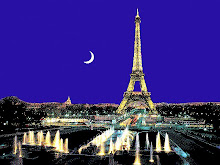Around Place de la Bastille - bis
Labels :
Family,
Foulée Verte,
Gare de la Bastille,
La Bastille,
Opéra Bastille,
Paloma,
Paris architecture
Referring to “Around Place de la Bastille”, I actually went back to la Bastille end last week for a rather surprising walk together with my son, his wife and my two grandchildren.
 Where you today can find the new Paris opera house, Opéra Bastille, used to be a railway station, Gare de la Bastille, for trains heading east, the Strasbourg line. The last – steam engined - train left the station in 1969 and it was demolished in 1984.
Where you today can find the new Paris opera house, Opéra Bastille, used to be a railway station, Gare de la Bastille, for trains heading east, the Strasbourg line. The last – steam engined - train left the station in 1969 and it was demolished in 1984.
 Where there used to be rails, there is now a green, park like, promenade, some 4,5 km (3 miles) eastwards. At the end you reach the green area Bois de Vincennes. This creation has clearly created added value to the surrounding quarters (including the price for a flat).
Where there used to be rails, there is now a green, park like, promenade, some 4,5 km (3 miles) eastwards. At the end you reach the green area Bois de Vincennes. This creation has clearly created added value to the surrounding quarters (including the price for a flat).
To start with you walk on a viaduct; the underneath 72 arcades are today used for some quite fashionable shops, restaurants and cafés. My granddaughter Paloma took the lead and the rest of the family had to follow.
My granddaughter Paloma took the lead and the rest of the family had to follow. She got fascinated by all the flowers and decided to have a closer look at most of them and of course ask for their names. (She did not learn very much due to lack of knowledge of her promenade partners.)
She got fascinated by all the flowers and decided to have a closer look at most of them and of course ask for their names. (She did not learn very much due to lack of knowledge of her promenade partners.)  Anyhow, we had a nice walk. To go back home, I took a municipal bike.
Anyhow, we had a nice walk. To go back home, I took a municipal bike.

 Where you today can find the new Paris opera house, Opéra Bastille, used to be a railway station, Gare de la Bastille, for trains heading east, the Strasbourg line. The last – steam engined - train left the station in 1969 and it was demolished in 1984.
Where you today can find the new Paris opera house, Opéra Bastille, used to be a railway station, Gare de la Bastille, for trains heading east, the Strasbourg line. The last – steam engined - train left the station in 1969 and it was demolished in 1984. Where there used to be rails, there is now a green, park like, promenade, some 4,5 km (3 miles) eastwards. At the end you reach the green area Bois de Vincennes. This creation has clearly created added value to the surrounding quarters (including the price for a flat).
Where there used to be rails, there is now a green, park like, promenade, some 4,5 km (3 miles) eastwards. At the end you reach the green area Bois de Vincennes. This creation has clearly created added value to the surrounding quarters (including the price for a flat).To start with you walk on a viaduct; the underneath 72 arcades are today used for some quite fashionable shops, restaurants and cafés.
 My granddaughter Paloma took the lead and the rest of the family had to follow.
My granddaughter Paloma took the lead and the rest of the family had to follow. She got fascinated by all the flowers and decided to have a closer look at most of them and of course ask for their names. (She did not learn very much due to lack of knowledge of her promenade partners.)
She got fascinated by all the flowers and decided to have a closer look at most of them and of course ask for their names. (She did not learn very much due to lack of knowledge of her promenade partners.)  Anyhow, we had a nice walk. To go back home, I took a municipal bike.
Anyhow, we had a nice walk. To go back home, I took a municipal bike.

























 Executions were public in France until 1937. The last execution took place in 1977 and capital punishment was officially - and I would add fortunately – at last abolished in 1981.
Executions were public in France until 1937. The last execution took place in 1977 and capital punishment was officially - and I would add fortunately – at last abolished in 1981. 

 The famous white Camarguais horses are used by the local “cowboys” (“gardians”), breeding fighting bulls, used for corridas in Spain and in France. Bull fighting, Spanish style, are common in southern France and are big events often taking place in the old Roman arenas. In the immediate neighbourhood, the spring “ferias” with several days of corridas at Nîmes and Arles are highly popular.
The famous white Camarguais horses are used by the local “cowboys” (“gardians”), breeding fighting bulls, used for corridas in Spain and in France. Bull fighting, Spanish style, are common in southern France and are big events often taking place in the old Roman arenas. In the immediate neighbourhood, the spring “ferias” with several days of corridas at Nîmes and Arles are highly popular.
 On the coast line you will find the small town of Saintes-Maries-de-la-Mer, with magnificent beaches and a lot of summer visitors. It’s also the site of an annual gipsy pilgrimage (May 24) for the veneration of Saint Sarah. It’s unclear who she really was, but the best known legend seems to be that Sarah was an Egyptian black maid of Marie Jacobe, sister of Virgin Mary, and Marie Salome, mother of the Apostles James and John. After the Crucifixion, Marie Jacobe and Marie Salome, accompanied by Lazarus, Mary Magdalene, Joseph of Arimathea (carrying the Holy Grail), some others… and Sarah, fled from the Holy Land and their boat landed at Saintes-Maries. You can find the statues of two Mary’s and Sarah in the local church.
On the coast line you will find the small town of Saintes-Maries-de-la-Mer, with magnificent beaches and a lot of summer visitors. It’s also the site of an annual gipsy pilgrimage (May 24) for the veneration of Saint Sarah. It’s unclear who she really was, but the best known legend seems to be that Sarah was an Egyptian black maid of Marie Jacobe, sister of Virgin Mary, and Marie Salome, mother of the Apostles James and John. After the Crucifixion, Marie Jacobe and Marie Salome, accompanied by Lazarus, Mary Magdalene, Joseph of Arimathea (carrying the Holy Grail), some others… and Sarah, fled from the Holy Land and their boat landed at Saintes-Maries. You can find the statues of two Mary’s and Sarah in the local church.
 Van Gogh also made a short visit here in 1888 and painted some boats on the beach and some houses in the village.
Van Gogh also made a short visit here in 1888 and painted some boats on the beach and some houses in the village.

 Here you can see, from left to right, Lyliane, Lucie and Hélène.
Here you can see, from left to right, Lyliane, Lucie and Hélène.
 We felt happy to be together and Hélène and André kindly invited us to their home in Fécamp, some 45 km or 30 miles away, on the coast. After visiting their home and garden (of course photographing the flowers), we went for a tour of Fécamp, including the port and the surrounding cliffs. Fécamp is also the home of the Benedictine liquor and the building you can see is the “Benedictine Palace”.
We felt happy to be together and Hélène and André kindly invited us to their home in Fécamp, some 45 km or 30 miles away, on the coast. After visiting their home and garden (of course photographing the flowers), we went for a tour of Fécamp, including the port and the surrounding cliffs. Fécamp is also the home of the Benedictine liquor and the building you can see is the “Benedictine Palace”. 
 We still wished to prolong and it all ended up with oysters, shrimp, fish… at Héléne’s and André’s home until late in the night.
We still wished to prolong and it all ended up with oysters, shrimp, fish… at Héléne’s and André’s home until late in the night. We all wished to meet again and if possible also with other bloggers. Great thanks again to Hélène for the good initiative!!
We all wished to meet again and if possible also with other bloggers. Great thanks again to Hélène for the good initiative!!





 Maybe all of you may not be aware that you can travel along the Seine by some kind of metro service, “hop on hop off”!!
Maybe all of you may not be aware that you can travel along the Seine by some kind of metro service, “hop on hop off”!! 












